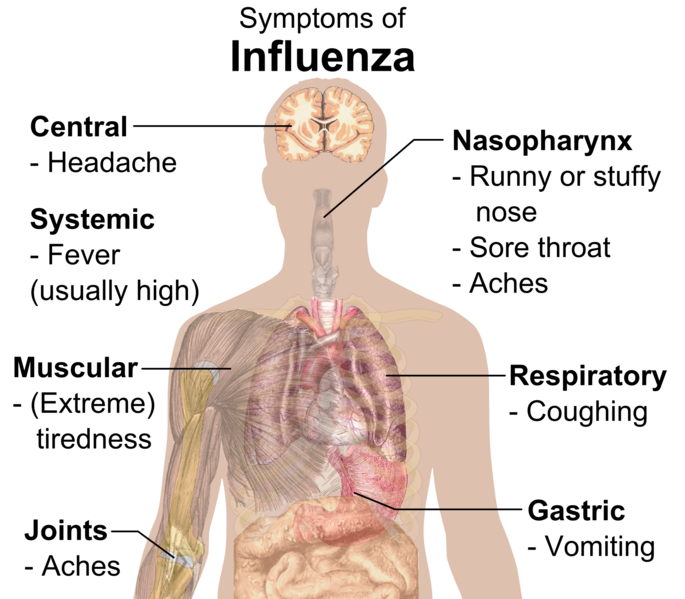 | ||||
Is it a Cold or the Flu?
How to Determine if You Have a Common Cold or Influenza
from Science Prof Online
To reduce the spread of influenza, the typical guideline is for those who are sick to stay home until fever-free for at least 24 hours. But if you begin feeling under the weather, how do you know if it’s the flu or just a miserable common cold?
Both influenza and the common cold are respiratory infections caused by viruses, but the flu tends to come on quickly, make a person feel severely ill, and present more danger of
Article Summary: A cold or the flu can make a person feel miserable, but with influenza now such a serious concern, it's important to know the difference between these two infections.
Do I Have a Cold or Is It the Flu?
 | ||||
You have free access to a large collection of materials used in a college-level introductory microbiology course. The Virtual Microbiology Classroom provides a wide range of free educational resources including PowerPoint Lectures, Study Guides, Review Questions and Practice Test Questions.
Page last updated: 6/2014
SCIENCE PHOTOS
SPO VIRTUAL CLASSROOMS
 | ||||||
SPO is a FREE science education website. Donations are key in helping us provide this resource with fewer ads.
Please help!
(This donation link uses PayPal on a secure connection.)
complications than does the common cold. Although colds and flu do share some symptoms, there are also symptoms that are more characteristic of one or the other. Here is a simple comparison of cold and flu symptoms.
Symptoms of Influenza
- Body Aches: Severe (+). Severe body aches and often associated with the flu.
- Chills: Common (+). Chills, shivering and feeling cold, are often present with the flu.
- Coughing: Common, without phlegm (+). A “dry” cough, one that does not produce mucus, is often present.
Symptoms of the Common Cold
- Coughing: Common, with phlegm (+). A “wet” cough, one that produces mucus, is often present.
- Nasal Congestion: Common (+). A stuffy nose is a typical symptom of those infected with a cold virus.
- Sneezing: Common (+).
- Sore Throat: Common (+). A scratchy or painful throat often occurs with a cold.
- Body Aches: Mild (-). Slight body aches and pains can be associated with the common cold.
- Chills: Uncommon (-).
- Exhaustion: Mild (-). A person with a cold usually feels mildly tired and worn out.
- Fever: Uncommon (-). A cold rarely results in fever.
- Headache: Uncommon (-). Headaches are not typically associated with colds, unless a result of sinus pressure due to nasal congestion.
- Chest Discomfort: Mild to Moderate (- / + ).
- Onset of Symptoms: Gradual. Cold symptoms typically develop over the course of a few days.
Coronaviruses are one type of virus known to cause the common cold. They have a halo, or crown-like (corona) appearance when viewed under an electron microscope.
- Exhaustion: Moderate to Severe (+).Fever: Common (+). Most people who get the flu develop a fever of over 100°F which typically lasts up to 4 days.
- Headache: Common (+). Most people with the flu do develop a headache.Nasal Congestion: Uncommon (-).
- Sneezing: Uncommon (-).
- Sore Throat: Uncommon (-).
- Chest Discomfort: Mild to Moderate (- / + ).
- Onset of Symptoms: Sudden. The flu comes on quickly, with fever, aches, pains and headache developing over the course of only a few hours.
Although this list can be helpful in distinguishing between cold and flu symptoms, it is definitely not a substitute for a professional medical diagnosis. If you are feeling ill, please see a doctor, not a computer.
Sources & Resources
- Centers for Disease Control, (2004) “Cold Versus Flu.”
- WebMD, (2009) “Flu or Cold Symptoms?”
- Can Changing Weather Make a Person Sick? article from Science Prof Online (SPO)
- Why Do People Catch Cold Viruses in Summer? article from SPO
- "Meet the Microbes: Viruses" Lecture Main Page from the Virtual Microbiology Classroom.
For more information on influenza and vaccination, check out >
"What You Should Know for the 2013 - 2014 Influenza Season", from the CDC
and
Find out why Joe Thomas of the Cleveland Browns gets his seasonal influenza vaccine.







